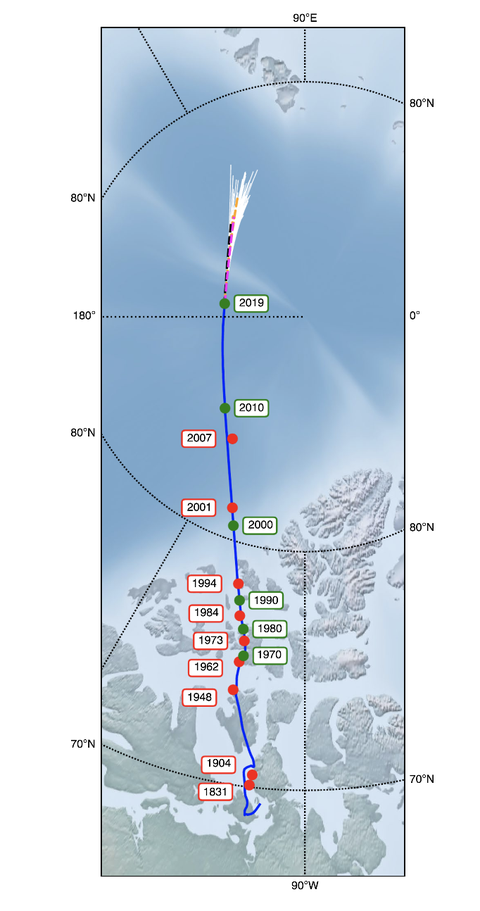28 Continental Drift: founding block of the Plate Tectonics Theory
The continental drift hypothesis, the foundation of Plate Tectonics theory was developed in the early part of the twentieth century, mostly by Alfred Wegener who proposed that continents move around on Earth’s surface and that they were once joined together as a single supercontinent called Pangaea. His hypothesis did not stand a trial at that time because nobody could explain the mechanism of the movement of continental plates.
Only with discoveries of ocean structure in 1960-1970s scientists understood the mechanism of plate movement.
See below a short documentary about the discovery of Plate Tectonics theory.
The Continental Drift Idea
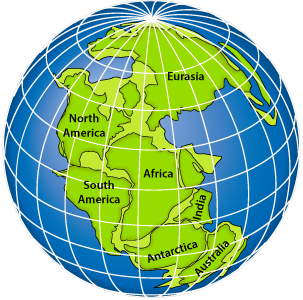
Figure 1. The continents fit together like pieces of a puzzle. This is how they looked 250 million years ago.
Alfred Wegener, a German climatologist, proposed that the continents were once united into a single supercontinent named Pangaea, meaning all earth in ancient Greek. He suggested that Pangaea broke up long ago and that the continents then moved to their current positions. He called his hypothesis continental drift.
Evidence for Continental Drift
Besides the way the continents fit together, Wegener and his supporters collected a great deal of evidence for the continental drift hypothesis.
- Identical rocks, of the same type and age, are found on both sides of the Atlantic Ocean. Wegener said the rocks had formed side-by-side and that the land had since moved apart.
- Mountain ranges with the same rock types, structures, and ages are now on opposite sides of the Atlantic Ocean. The Appalachians of the eastern United States and Canada, for example, are just like mountain ranges in eastern Greenland, Ireland, Great Britain, and Norway (figure 2). Wegener concluded that they formed as a single mountain range that was separated as the continents drifted.

Figure 2. The similarities between the Appalachian and the eastern Greenland mountain ranges are evidences for the continental drift hypothesis.
- Ancient fossils of the same species of extinct plants and animals are found in rocks of the same age but are on continents that are now widely separated (figure 3). Wegener proposed that the organisms had lived side by side, but that the lands had moved apart after they were dead and fossilized. He suggested that the organisms would not have been able to travel across the oceans.
- Fossils of the seed fern Glossopteris were too heavy to be carried so far by wind.
- Mesosaurus was a swimming reptile but could only swim in fresh water.
- Cynognathus and Lystrosaurus were land reptiles and were unable to swim.
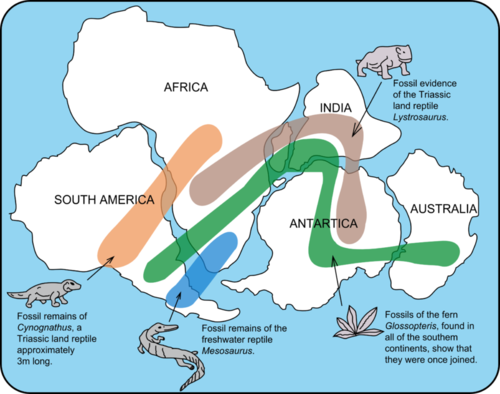
- Grooves and rock deposits left by ancient glaciers are found today on different continents very close to the equator. This would indicate that the glaciers either formed in the middle of the ocean and/or covered most of the Earth. Today glaciers only form on land and nearer the poles. Wegener thought that the glaciers were centered over the southern land mass close to the South Pole and the continents moved to their present positions later on.
- Coral reefs and coal-forming swamps are found in tropical and subtropical environments, but ancient coal seams and coral reefs are found in locations where it is much too cold today. Wegener suggested that these creatures were alive in warm climate zones and that the fossils and coal later had drifted to new locations on the continents.
Although Wegener’s evidence was sound, but most geologists at the time rejected his hypothesis of continental drift. Why do you think they did not accept continental drift?
Scientists argued that there was no way to explain how solid continents could plow through solid oceanic crust. Wegener’s idea was nearly forgotten until technological advances presented even more evidence that the continents moved and gave scientists the tools to develop a mechanism for Wegener’s drifting continents.
Magnetic Polarity Evidence

Figure 4. Earth’s magnetic field is like a magnet with its north pole near the geographic North Pole and the south pole near the geographic South Pole.
Puzzling new evidence came in the 1950s from studies on the Earth’s magnetic history (figure 4).
Scientists used magnetometers, devices capable of measuring the magnetic field intensity, to look at the magnetic properties of rocks in many locations.
Magnetic Pole Moving?
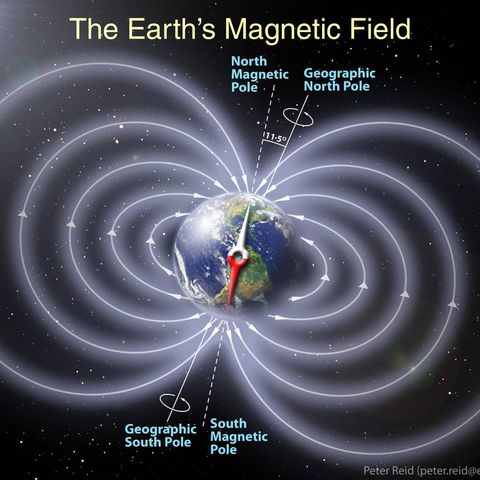 https://www.popularmechanics.com/science/environment/a32496561/why-magnetic-north-pole-moving/
https://www.popularmechanics.com/science/environment/a32496561/why-magnetic-north-pole-moving/
Geologic Approach to Magnetic Pole Wandering
All igneous rocks have magnetite, a mineral consisting mainly of iron. Igneous rocks can be found in many parts of the world.
Magnetite crystals are like tiny magnets that point to the north magnetic pole as they crystallize from magma. The crystals record both the direction and strength of the magnetic field at the time. The direction is known as the field’s magnetic polarity.
Geologists noted important things about the magnetic polarity of different aged rocks on the same continent:
- Magnetite crystals in fresh volcanic rocks point to the current magnetic north pole (figure 5) no matter what continent or where on the continent the rocks are located.

- Older rocks that are the same age and are located on the same continent point to the same location, different from the current north magnetic pole.
- Older rock that are of different ages do not point to the same locations or to the current magnetic north pole.
In other words, although the magnetite crystals were pointing to the magnetic north pole, the location of the pole seemed to wander. Scientists were amazed to find that the north magnetic pole changed location through time (figure 6).

Figure 6. The location of the north magnetic north pole 80 million years before present (mybp), then 60, 40, 20, and now.
There are three possible explanations for this:
1. The continents remained fixed and the north magnetic pole moved.
2. The north magnetic pole stood still and the continents moved.
3. Both the continents and the north pole moved.
During studies of magnetism in various countries geologists noted that for rocks of the same age on different continents, the magnets pointed to different magnetic north poles.
-
-
- 400-million-year-old magnetite in Europe pointed to a different north magnetic pole than the same-aged magnetite in North America.
- 250 million years ago, the north poles were also different for the two continents.
-
The scientists looked again at the three possible explanations. Only one can be correct.
If the continents had remained fixed while the north magnetic pole moved, there must have been two separate north poles.
Since there is only one north pole, the only reasonable explanation is that the north magnetic pole has remained fixed but that the continents have moved.
To test this, geologists fitted the continents together as Wegener had done. It worked!
There has only been one magnetic north pole and the continents have drifted (see figure below). The view on this map is from the north down (polar projection).
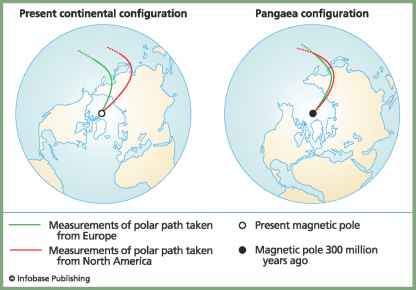 Source: https://www.fossilhunters.xyz/plate-tectonics-3/stanley-runcorn-discovers-wandering-poles.html
Source: https://www.fossilhunters.xyz/plate-tectonics-3/stanley-runcorn-discovers-wandering-poles.html
The maps above show the polar wandering curve through Pangaea as well as through the present day configuration, which provides further evidence for moving tectonic plates.
This evidence for continental drift gave geologists renewed interest in understanding how continents could move about on the planet’s surface.
Lesson Summary
-
- In the early part of the 20th century, scientists began to put together evidence that the continents could move around on Earth’s surface.
- The evidence for continental drift included the fit of the continents; the distribution of ancient fossils, rocks, and mountain ranges; and the locations of ancient climatic zones.
- Although the evidence for continental drift was extremely strong, scientists rejected the idea because no mechanism for how solid continents could move around on the solid earth was developed.
- The discovery of apparent polar wander renewed scientists interest in continental drift.
